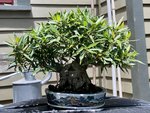Yeah sorry these pics blow. I'll go get some better shots and try to update a proper post.
So in the large trident defoliated...
Over on the left you can sorta see a low shoot with leaves on the end. Blurred and tiny I know....sry. So that was defoliated but the tip growth was left uncut and it did regrow the new leaves without much new extension. The regrown leaves on the shoot is shown here. So it does seem to reflush even without cutting the tips too.
View attachment 304638
But for sure on a crepe myrtle I've never seen any latent growth/ramification from leaf removal. Only cut points. That's the first pic of the triple. Pretty much exactly what you referred to.
I'll look to see about what tropical pics I can drum up. I know with most ficus when leaving the growing tip while defoliating you will definitely get deeper budding. But this may be more of tropicals strictly reacting to the renewed sunlight on the interior and not any genetic reasons.









